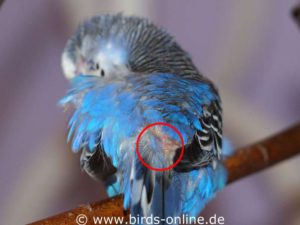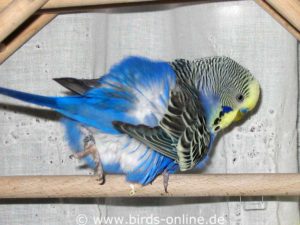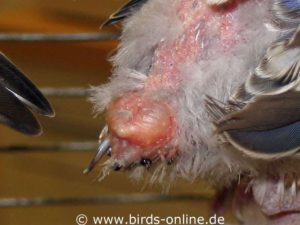- >>
- Birds Online – English
- >>
- Health and diseases
- >>
- General health topics
- >>
- Bird anatomy
- >>
- Preen gland
Preen gland

At the low back right above the tail-base, the preen gland is located in budgies and many other bird species. There are some more names for this part of a bird’s body like preening gland, tail gland, oil gland, and uropygial gland. In case a bird is healthy and as an intact plumage, the naked preen gland is covered by the surrounding feathers. It is quite flat and hard to see even if you gently stroke the feathers to the side.
The preen gland supplies the birds with the oily secretion which is needed for their plumage-care. Every day, the birds apply this greasy secretion to their feathers. This procedure is extremely important for the budgies and other birds. Because to be able to survive in nature, birds always need a well cared for plumage.

For many birds, it is also of great importance that their plumage is water-repellent. However, since feathers would quickly become soaked with water if they were not provided with a protective layer, the plumage needs natural moisture protection. The birds achieve this by applying the oil from their preen gland to feathers.
The secretion is evenly spread over the plumage with the beak and by rubbing the head at the lower back, for example. They do this because they can’t reach their own back of the head with their beak. For preening the feathers around the cloaca, some budgies first apply the secretion taken from their preen gland on one of their feet. Then they rub their foot on the feathers surrounding the cloaca.
Diseases of the preen gland

A bird’s preen gland can become inflamed or clogged. Besides, tumors or other tissue alterations can occur in this part of the body. You will find further information on diseases of the preen gland in this chapter (soon to come!). For you, as a bird owner, it is important to know the typical alarm signals. Any inflammation or blockage of the preen gland causes the budgies heavy pain. In many cases, the birds try to get some relief and bite themselves until they bleed. Since the plumage covers the oil gland, the actual wound often isn’t visible. The owners just notice the blood on the beak. So when you’re looking for a wound that is hidden by the feathers, don’t forget to check the preen gland.
By the way, birds who suffer from a severe plumage disorder are often affected by inflammations or blockages of the preen gland. The reason is that they don’t preen on a daily base and the secretion, therefore, remains unused. Over time, it becomes hardened and a blockage or inflammation of the gland develops. The photo close to this paragraph shows a budgie suffering from PBFD. You can easily see the large swelling cause by a preening gland blockage and inflammation.
